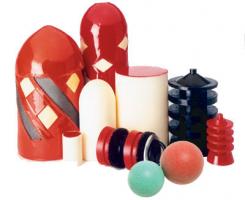Pigging
Pigging in reference to the oil & gas industry is the use of a piece of equipment called a "pig" to perform various pipeline maintenance and operational requirements. This is also called "pipeline pigging".
How Pigging Works
Pigs are inserted into a "pig launcher or pig sender" or through the use of a "pig valve". The gas pressure from the fluid flowing in the line pushes the pig down the pipeline. At the end of the pipeline is a "pig catcher or pig receiver" or "pig valve". Any fluids or solids in the pipeline will be pushed into the pig catcher or pig receiver where it can be cleaned out.
Purpose for Pigging Pipelines
- Cleaning
- Inspection
- Hydrostatic Pressure Testing
- Coating
- Batch Fluid Transportation
1. Cleaning
Cleaning of a pipeline with pigs is a common operation in the oil & gas industry. Pipelines are cleaned remove liquid buildup natural gas pipelines, solids, scale, paraffin wax buildup, and other debris that builds up in a pipeline. Pipelines are cleaned to insure that the flow in the line is running optimally with no restrictions. Pipeline cleaning also reduces corrosion caused by liquid buildup in the line.
2. Inspection
Pigs can be used to inspect pipelines. This is also known as in-line inspection (ILI). Gauging or sizing pigs are run down a pipeline to determine if there are if there is any damage or obstructions in new or existing pipelines. Smart pigs may also be used. Smart pigs are equipped with magnetic and ultrasonic systems which monitor and record the wall thickness of the pipeline to determine the integrity of a pipeline. This information can be used to determine the areas of internal and external corrosion, damage or any other deformation in the pipeline wall.
3. Hydrostatic Pressure Testing
During hydrostatic pressure testing, pigs are used to fill the pipeline with water or water/methanol or other testing fluid and to also dewater the line after the hydrostatic test is completed. To fill a pipeline, the pig is inserted ahead of the testing fluid. The fluid is pumped or compressed into the line. The pig forces out all the existing air, gas, or liquid in the line. This allows for a proper pressure test. Once the pressure test is completed, the line is pigged to force out the testing fluid to dry the line for operation.
4. Coating
Pigs can be used to internally coat a pipeline. In a typically installation of internal coating the pipeline is first mechanically cleaned. The pipeline is then chemical cleaned and prepared to improve the coating adhesion. The pipeline is then dried and internally coated. This process typically done by batching pigging.
5. Batch Fluid Transportation
Pigs can be used to physically separate multiple liquids which can all be sent down the same pipeline. This is called "batch" transportation. This may include gasoline, diesel fuel, and other hydrocarbon liquids which are all separated by pigs.
Type of Pigs
Cleaning pigs may be consist of a steel frame with polyurethane body, open-cell polyurethane foam, and single-body cast-polyurethane. Some steel frame pigs have brushes, tungsten studs, or wire mesh on the outside to clean off rust, scale, or wax that builds up on the pipeline walls. Cleaning pigs may be in the shape of a bullet or sphere and can be a range of densities depending on the application.
Associated Categories |
| Pigs & Pigging Products |
Comments regarding


